Access Preparation
Good visibility and accessibility are necessary to carry out an endodontic treatment satisfactorily. To achieve this, the access preparation must be made so that it is possible to inspect the coronal part of the pulp cavity visually and with instruments after completion of the opening of the pulp chamber. In many instances (probably most) when patients have been referred to an endodontist because a started endodontic treatment has "gone wrong", the cause is poor access preparation.
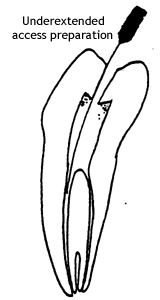
Underextended access preparations may cause canals to be overlooked, anatomical divergences will not be detected, and infected material will be left in the root canal and that necrotic tissue remaining in the pulp chamber will cause discoloration of the crown. Furthermore, a narrow access preparation may direct a bur or root canal instrument and increase the risk of perforation. It is more important to have good access than to save a cusp, because a good root filling is necessary to keep an endodontically involved tooth.
Procedure
Remove all caries and fillings that stand in the way of view or that can cause leakage. Undermined enamel shall also be removed together with parts of the crown that make accessability to the canal(s) difficult e.g., mesiobuccal cusps of molars.
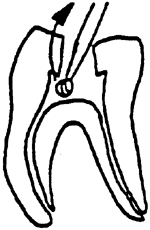 If
there is a pulp exposure, it should be widened, in order to properly determine
the extention of the pulp chamber. In this way a proper access preparation
can be made. When there is no exposure, access should be made by drilling
towards a large pulp horn or the largest area of the pulp chamber. During
the access preparation the bur should be used with a pull stroke from
the pulp chamber and out.
If
there is a pulp exposure, it should be widened, in order to properly determine
the extention of the pulp chamber. In this way a proper access preparation
can be made. When there is no exposure, access should be made by drilling
towards a large pulp horn or the largest area of the pulp chamber. During
the access preparation the bur should be used with a pull stroke from
the pulp chamber and out.
Using this technique of access preparation, it is possible to avoid perforating the floor of the pulp chamber and to get smooth walls without ledges. The access preparation is done with round burs. Long shank round burs are occasionally necessary. The use of fissure burs very often creates ledges in the floor and walls of the cavity access preparation. Such ledges make the canal instrumentation more difficult. Moreover, ledges in the dentin can diminish the tensile strength of the tooth.
When completed, the access preparation should be shaped without overhanging edges. In the following schematic drawings the access preparations are drawn with dotted lines.
Central Maxillary Incisor
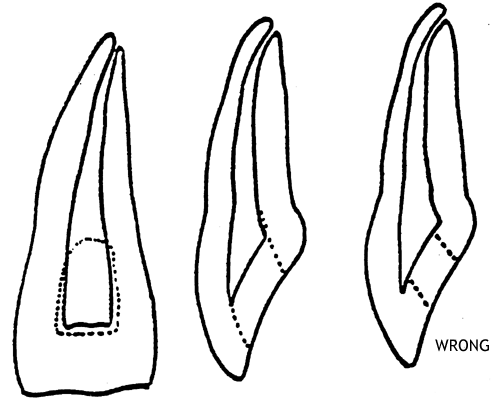
|
Average
Length:
|
22.5 mm |
|
Number
of canals:
|
1 |
|
Root
development completed at 10 years of age.
|
|
The preparation is begun from the palatal surface. The access cavity must be extended in an incisal direction. Too narrow an access cavity (according to wrong in the figure) can leave tissue remnants in the pulp horns which can cause discoloration of the crown.
Lateral Maxillary Incisor
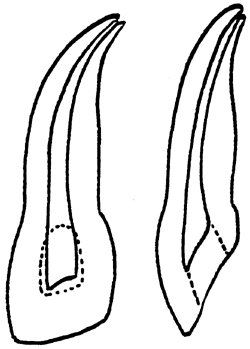
|
Average
Length:
|
22 mm |
|
Number
of canals:
|
1 |
|
Root
development completed at 10 years of age.
|
|
The access preparation of the lateral incisor is also begun from the palatal surface. The root canal is wide in proportion to the root and also there is usually a distopalatal curve in the apical third of the canal. Therefore, the canal must be instrumented carefully to avoid perforation.
Maxillary Canine
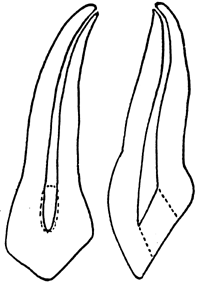
|
Average
Length:
|
26.5 mm |
|
Number
of canals:
|
1 |
|
Root
development completed at 14 years of age.
|
|
The access preparation is begun from the palatal surface. The root is often curved apically. This is the longest tooth and therefore considerable widening of the the root canal is needed in order to do a proper root filling.
First Maxillary Premolar
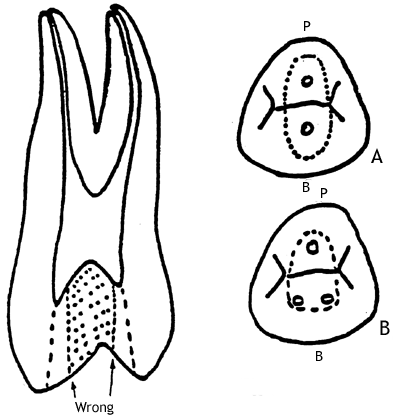
|
Average
Length:
|
20.6 mm |
|
Number
of canals:
|
1 - 19.5% |
| 2 - 79.5% | |
| 3 - 1% | |
|
Root
development completed at 13 years of age.
|
|
- When there are two root canals, one is buccal and the other is palatal.
- When there are three root canals, there are two buccal canals and one palatal.
The access preparation is begun from the occlusal surface. It is sometimes necessary to cut the cusps to get an adequate view. If the access cavity is not adequately extended buccally and palatally; pulpal remnants will be left undetected. ("wrong" in the figure).
Mesially, there is a concavity of the root surface and there is an increased risk of mesio-cervical perforation during access preparation because of this.
The roots of the first maxillary premolar are often slender and curved; contours are sometimes difficult to see on the radiograph.
Second Maxillary Premolar
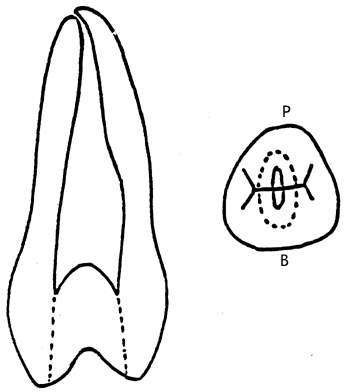
|
Average
Length:
|
21.5 mm |
|
Number
of canals:
|
1 - 56% |
| 2 - 42% | |
| 3 - 2% | |
|
Root
development completed at 14 years of age.
|
|
The access preparation is again made through the occlusal surface. The root canal in this usually single rooted tooth is band shaped. When there are two canals, one is buccal and one palatal. When there are three canals, two are buccal and one palatal.
First and Second Maxillary Molars
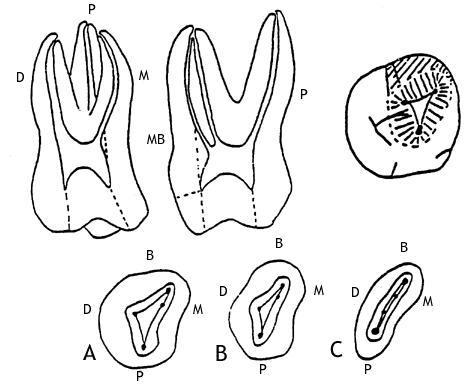
|
Average
Length:
|
first maxillary molar 20.8 mm |
| second maxillary molar 20.0 mm | |
|
Number
of canals:
|
first maxillary molar 3 - 47%, 4 - 53% |
| second maxillary molar 3 - 59%, 4 - 46% | |
|
Occasionally
there are first and second maxillary molars with 1,2, and 5 canals.
|
|
|
Root
development completed at age:
|
first maxillary molar - 9 |
| second maxillary molar - 15 | |
The access preparation in a maxillary molar is through the occusal surface. Very often it is necessary to reduce the mesiobuccal cusp in order to obtain straight line access to mesiobuccal canal orifice. If there are two canals, they are usually connected, but there are mesiobuccal roots that have two separate canals. Also, there are occasionally two mesiobuccal roots. The palatal and distobuccal roots have one canal each.
The mesiobuccal, distobuccal and palatal canal orifices are situated in the "Corners" of the pulp chamber. The location of these orifices represent the vertices of a triangle. The mesiopalatal orifice is mostly situated on a mentally scribed line between the mesiobuccal and palatal canal orifices (A,B). It is not uncommon, especially in the second molar, where the pulp chamber is narrow, for the canal orifices to be more or less in line. (C).
Mandibular Incisors
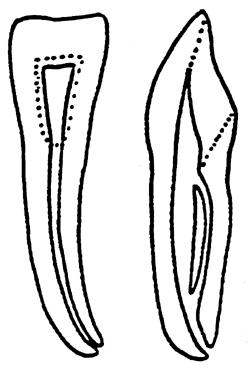
|
Average
Length:
|
11.7 mm |
|
Number
of canals:
|
1 - 62% |
| 2 - 38% | |
|
Root
development completed at 10 years of age.
|
|
Access preparation is done from the lingual surface of the crown. Note that the access cavity has to be extended in a linguo-cervical direction to make it possible to localize a lingual canal. Mostly, the lingual canal joins the buccal canal (see illustration), but separate foramina can occur.
Mandibular Canine
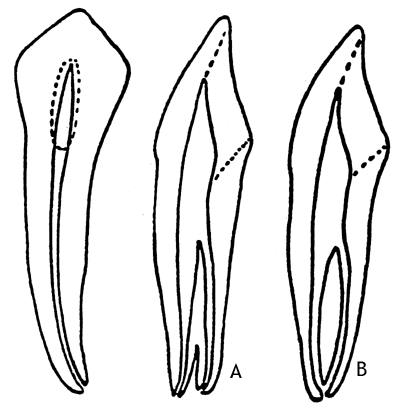
|
Average
Length:
|
25.6 mm |
|
Number
of canals:
|
1 - 57% |
| 2 - 43% | |
|
Root
development completed at 14 years of age.
Occasionally there are mandibular canines with two roots. |
|
Access preparation is done lingually. The access cavity has to be extended in a linguo-cervical direction to make a localization and instrumentation of a lingual canal possible.
The lingual canal can be situated in a lingual root (A) or join the buccal canal in a common foramen (B) or have a separate foramen within the same root as the buccal canal.
First and Second Mandibular Premolars
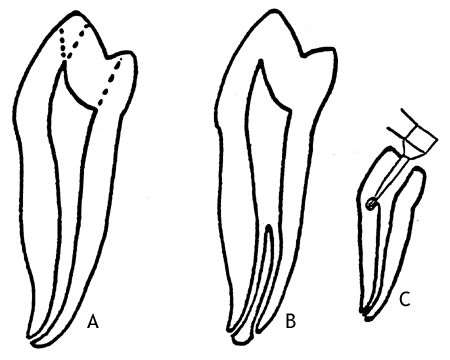
|
Average
Length:
|
first mandibular premolar 21.6 mm |
| second mandibular premolar 22.3 mm | |
|
Number
of canals:
|
first mandibular premolar 1 - 98%, 2 - 8% |
| (According to "clinical experience", first mandibular premolars with two root canals are more common than the frequency found by Hess in 1917.) | |
| second mandibular premolar 1 - 92%, 2 - 8% | |
|
Occasionally
there are first and second maxillary molars with 1,2, and 5 canals.
|
|
|
Root
development completed at age:
|
first mandibular premolar 13 |
| second mandibular premolar 14 | |
Access preparation is done occlusally. Very often the occlusal surface is pointing lingually and to make instrumentation of the canal(s) possible, the access cavity must be extended facially (according to the most facial dotted line on Fig A.) and in some cases it is necessary to reduce the facial cusp. If this is not done properly there is a risk for perforation because of interference by the facial cusp during access preparation and canal instrumentation. (C) Where there are two canals, one is buccal and the other, lingual and the division is two canals from the main canal mostly takes place in the apical third of the root (B).
First and Second Mandibular Molars
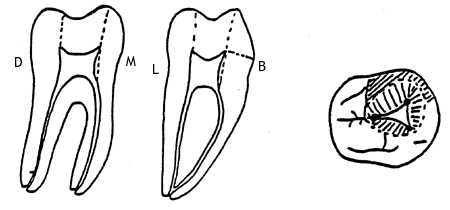
|
Average
Length:
|
first mandibular molar 21.0 mm |
| second mandibular molar 19.8 mm | |
|
Number
of canals:
|
1 - 0.5% 2 - 18.0% 3 - 79.5% 4 - 2.0% |
|
Root
development completed at age:
|
first mandibular molar 10 |
| second mandibular premolar 15 |
Access preparation is done occlusally. In most instances it is necessary to cut the mesiobuccal cusp to obtain proper accessibility.
When there is only one canal, this canal is wide, straight and centrally located. Mandibular molars with two canals have one distal and one mesial canal usually situated in distal and mesial roots. When there are three canals there are two mesial and one distal. Teeth with four canals have two mesial and two distal canals. The canal(s) of the mesial root often have many ramifications that can make their instrumentation and cleaning difficult.